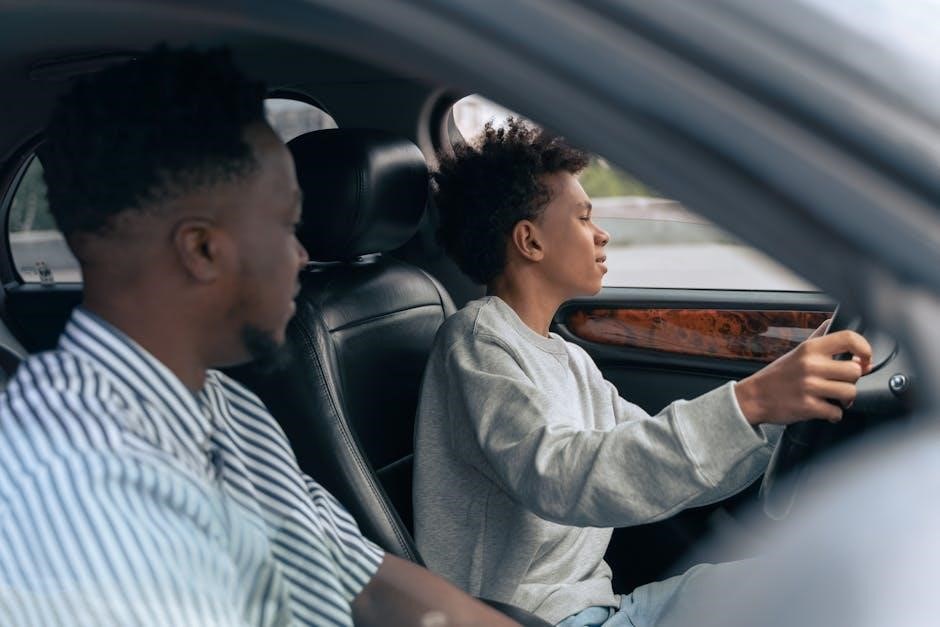Understanding the Importance of Parental Involvement in Driving Education
Parents play a vital role in driving education, offering personalized attention and reinforcing learning. Their involvement builds confidence, ensures safety, and fosters a supportive environment for new drivers.
1.1 The Role of Parents in the Learning Process
Parents act as guides and role models, providing one-on-one training tailored to their teen’s learning pace. They help set expectations, choose practice environments, and reinforce safe driving habits. By actively participating, parents ensure consistent feedback and structured practice, fostering confidence and competence. Their involvement creates a supportive learning environment, enabling teens to gradually master driving skills and develop responsible attitudes behind the wheel.
1.2 Benefits of Parent-Led Driving Lessons
Parent-led driving lessons provide personalized attention, allowing teens to learn at their own pace. They offer flexibility in scheduling and practice environments, making the process more comfortable and effective. This approach also reduces costs compared to professional schools. By practicing with a trusted parent, teens build confidence and develop safe driving habits in a familiar and supportive setting. Parental involvement fosters responsibility and ensures consistent feedback, which are key to becoming a competent and cautious driver.

Preparing for the Driving Lessons
Setting clear expectations, choosing safe practice locations, and understanding local driving laws are essential steps to ensure a productive and safe learning experience for new drivers.
2.1 Setting Clear Expectations and Goals
Establishing clear expectations and goals is crucial for effective driving lessons. Parents should create a structured plan, aligning with the learner’s permit requirements and progressing at the teen’s pace. Setting specific, achievable objectives helps track progress and builds confidence. Discussing these goals openly ensures both parent and teen are aligned, fostering a focused and productive learning environment. Regular check-ins to review achievements and adjust targets keep the process motivated and goal-oriented.
2.2 Choosing the Right Practice Environment
Selecting the right practice environment is essential for safe and effective learning. Begin with an empty parking lot to focus on basic vehicle control, such as starting, stopping, and turning. Gradually move to quiet, low-traffic streets to introduce more complex scenarios. Avoid busy areas until confidence and skills improve. Ensure the environment is free from distractions and hazards, allowing the teen to focus on developing their driving abilities. Weather conditions should also be considered for safety.
2.3 Understanding Local Driving Laws and Regulations
Understanding local driving laws and regulations is crucial for effective teaching. Parents should familiarize themselves with specific rules, such as age requirements, permitted driving hours, and necessary documentation. Knowledge of traffic laws, speed limits, and right-of-way rules ensures compliance and safety. Staying informed about local regulations helps parents set clear expectations and guide their teen in adhering to legal standards, fostering responsible driving habits from the start.

Building a Structured Learning Plan
A well-organized learning plan ensures gradual skill development, starting with basics like parking lot practice; It helps parents track progress and tailor lessons to their teen’s needs effectively.
3.1 Starting with the Basics: Parking Lot Practice
Begin with parking lot practice to help your teen master fundamental driving skills in a safe, controlled environment. Start with basic vehicle control, such as starting, stopping, and turning. Empty parking lots provide minimal distractions, allowing your teen to focus on coordinating actions and building confidence. This foundational step is crucial for developing smooth and precise movements before progressing to more complex driving scenarios. Regular practice in this setting helps reinforce proper techniques and ensures a solid skill base for future lessons.
3.2 Gradually Introducing More Complex Driving Scenarios
After mastering basic skills, gradually introduce more challenging driving scenarios, such as navigating intersections, roundabouts, and highways. Start in low-traffic areas to ease your teen into real-world conditions. Practice merging, maintaining speed, and responding to traffic signals. Use practice checklists to track progress and ensure readiness for each new challenge. This step-by-step approach builds confidence and competence, preparing your teen for the diverse situations they’ll encounter on the road.
3.3 The Importance of Practice Checklists
Practice checklists are essential for tracking progress and ensuring all critical driving skills are mastered. They provide a clear structure, helping parents and teens stay organized and focused. Checklists allow you to identify areas needing more practice and confirm when skills are proficient. By systematically checking off each task, teens gain confidence and competence. Regularly reviewing the checklist ensures comprehensive learning and prepares your teen for more advanced driving challenges.

Safety First: Teaching Defensive Driving Techniques
Defensive driving techniques are crucial for minimizing risks on the road. Teach hazard perception, emergency procedures, and vehicle maintenance to ensure your teen drives safely and responsibly.
4.1 Hazard Perception and Awareness
Hazard perception and awareness are critical skills for new drivers. Teach your teen to identify potential dangers like pedestrians, vehicles, and road conditions. Encourage them to stay alert and anticipate the actions of other road users. Discuss how to maintain focus and react appropriately to unexpected situations. Regular practice in various driving environments helps improve their ability to recognize and respond to hazards effectively, reducing the risk of accidents and enhancing overall safety on the road.
4.2 Emergency Procedures: What Every New Driver Should Know
Teach your teen essential emergency procedures, such as securing the vehicle, using hazard lights, and staying calm in unexpected situations. Ensure they know how to handle a breakdown, flat tire, or medical emergency while driving. Practice scenarios like skidding or hydroplaning to build their reaction skills. Emphasize the importance of calling for help and staying visible. Regularly review these procedures to ensure they are prepared for any critical situation that may arise on the road.
4.3 The Role of Vehicle Maintenance in Safety
Regular vehicle maintenance is crucial for safety. Teach your teen to check tire pressure, oil levels, and brakes. Ensure all lights and signals function properly. A well-maintained car reduces the risk of breakdowns and ensures reliability. Encourage your teen to schedule regular inspections and address issues promptly. This practice helps build a safety-conscious mindset and prepares them to handle unexpected situations confidently.

Communicating Effectively with Your Teen
Effective communication is key to successful driving lessons. Stay calm, listen actively, and provide clear, constructive feedback. Encourage open dialogue to address concerns and build confidence.
5.1 Staying Calm and Patient During Lessons
Remaining calm and patient is crucial during driving lessons. Avoid frustration by setting realistic expectations and celebrating small progress. Deep breathing can help manage stress, ensuring a positive learning environment. Teens thrive when supported, not criticized, so focus on encouragement. Patience fosters confidence and reduces anxiety, making the learning process smoother. By staying composed, you create a safe space for your teen to practice and improve their driving skills effectively.
5.2 Providing Constructive Feedback
Constructive feedback is essential for helping your teen improve their driving skills. Focus on specific actions rather than general criticism, using phrases like, “Next time, try slowing down earlier.” Avoid overwhelming them with too much information at once. Instead, address one or two key areas for improvement. Timing is crucial—offer feedback immediately after the action while it’s fresh in their mind. Encourage open dialogue by asking questions like, “How do you think you could handle that situation differently?” This fosters a supportive and collaborative learning environment.
5.3 Encouraging Open Dialogue About Driving Concerns
Creating an open dialogue fosters trust and helps your teen feel comfortable discussing driving challenges. Encourage them to share their thoughts and concerns without fear of judgment. Ask open-ended questions like, “What do you think was tricky about that situation?” Listen actively and acknowledge their feelings. This supportive approach helps them feel heard and understood, promoting a collaborative learning environment. Encourage them to ask questions and seek clarification, reinforcing that it’s okay to make mistakes and learn from them.

Practicing Specific Driving Skills
Focus on mastering basic vehicle control, such as starting, stopping, and turning. Gradually introduce navigating intersections, roundabouts, and merging onto highways to build confidence and competence.
6.1 Mastering Basic Vehicle Control: Starting, Stopping, and Turning
Mastering basic vehicle control is essential for new drivers. Start with practicing smooth acceleration and controlled stopping in a safe environment, like an empty parking lot. Turning requires clear visibility and proper signaling. Encourage your teen to focus on coordination between the steering wheel and pedals. Gradually introduce turning at varying speeds and angles to build muscle memory. Use practice checklists to track progress and ensure confidence in these fundamental skills before moving to more complex scenarios.
6.2 Navigating Intersections and Roundabouts
Navigating intersections and roundabouts requires careful observation and decision-making. Teach your teen to approach intersections with caution, using turn signals and checking for traffic and pedestrians. At roundabouts, emphasize entering at a safe speed, yielding to traffic already in the circle, and signaling when exiting. Practice these scenarios in low-traffic areas to build confidence. Focus on understanding right-of-way rules and maintaining a safe distance from other vehicles to ensure smooth and safe navigation.
6.3 Merging onto Highways and Maintaining Speed
Merging onto highways requires smooth acceleration and awareness of surrounding traffic. Teach your teen to match their speed to highway traffic before merging and use turn signals. Emphasize checking mirrors and blind spots for safe integration. Once on the highway, maintaining a steady speed is crucial. Encourage adjusting to traffic flow and keeping a safe distance. Practicing on-ramp acceleration and speed adjustment in low-traffic conditions can build confidence and ensure a seamless transition to highway driving.

Understanding the Licensing Process
Obtaining a learner’s permit is the first step, followed by logging required practice hours under a supervising driver. Understanding state-specific regulations ensures compliance and smooth progression toward full licensure.
7.1 Obtaining a Learner’s Permit: Requirements and Process
Obtaining a learner’s permit is the initial step in the licensing process. Teens typically must be at least 16 years old (or 15 in some regions) to apply. Parents must provide proof of identity, residency, and legal guardianship. A vision test is usually required, and some states allow online applications for convenience. Once the application is approved, a written test on road rules and traffic signs is administered; A small fee is charged, and the permit is issued, enabling supervised practice driving under a licensed adult’s guidance.
7.2 The Role of a Supervising Driver
A supervising driver must be a licensed adult, typically 21 years or older, with a valid driver’s license. They are responsible for guiding the learner in a safe and supportive manner. Key duties include ensuring practice sessions focus on essential driving skills, adhering to traffic laws, and logging required practice hours. The supervising driver also provides constructive feedback to help the learner improve and prepares them for the licensing test by addressing areas needing refinement.
7.3 Logging Practice Hours: What You Need to Know
Logging practice hours is crucial for tracking progress and ensuring compliance with licensing requirements. Most states require a minimum number of supervised driving hours, both daytime and nighttime. Parents must accurately record dates, durations, and types of practice to avoid delays in licensing. Using a log sheet or app can help maintain organization. This documentation ensures the learner meets legal standards and demonstrates readiness for the driver’s test, making it a critical step in the licensing process.

Preparing for the Driving Test
Understanding the test format and criteria is essential. Conduct a final practice session focusing on common test scenarios. Ensure your teen feels calm and confident behind the wheel.
8.1 Understanding the Test Format and Criteria
The driving test evaluates essential skills like vehicle control, traffic law knowledge, and safe driving practices. Typically, it includes a vision test, a review of vehicle safety checks, and a practical driving assessment. Examiners observe how well the teen follows traffic rules, signals, and navigates various road scenarios. Understanding the specific criteria helps parents focus practice sessions on areas needing improvement, ensuring the teen is well-prepared to demonstrate competence and confidence during the test.
8.2 Conducting a Final Practice Session
A final practice session should simulate the actual driving test to help your teen feel prepared. Focus on routes or scenarios likely to appear on the test, such as stopping at intersections, turning, and merging. Encourage your teen to demonstrate their ability to follow traffic rules and maintain safe habits. Provide calm, constructive feedback to address any remaining weaknesses. This session builds confidence and ensures they are ready to perform at their best during the official test.
8.3 Helping Your Teen Stay Calm and Confident
Creating a calm environment is key to helping your teen stay confident. Encourage positive affirmations and remind them of their progress. Teach relaxation techniques like deep breathing to reduce test-day anxiety. Avoid criticism and focus on constructive encouragement. Remind them that mistakes are part of learning and not a reflection of their abilities. A pre-test routine, such as a short practice or reassuring conversation, can help ease nerves. Your support and belief in their skills will boost their confidence and readiness for the test.

Additional Resources and Support
Utilize online driving guides, enroll in professional schools, and leverage technology like apps to enhance learning. These resources provide structured lessons, expert guidance, and interactive tools for success.
9.1 Using Online Driving Guides and Tutorials
Online driving guides and tutorials offer comprehensive resources for teaching driving skills. They provide structured lessons, video tutorials, and practice exercises to cover essential topics like road safety, traffic laws, and vehicle control. These tools often include interactive quizzes and progress tracking to ensure learners master each skill. Parents can access expert tips and real-world scenarios to supplement their teaching. Utilizing these resources helps create a well-rounded learning experience tailored to the learner’s needs and pace.
9.2 Enrolling in a Professional Driving School
Enrolling in a professional driving school provides structured, expert-led instruction tailored to your teen’s needs. These programs often include comprehensive curricula, hands-on training, and feedback from certified instructors. Many schools focus on building safe driving habits and boosting confidence. They also cover advanced topics like defensive driving and emergency maneuvers. Some schools offer additional resources, such as online courses or practice logs, to support learning. This professional guidance can complement parental involvement, ensuring a well-rounded driving education experience for your teen.
9.3 Leveraging Technology: Apps for Driving Practice
Technology offers innovative tools to enhance driving practice. Apps like Driving School Simulator and Drivemode provide interactive lessons, virtual simulations, and progress tracking. These apps help teens practice hazard perception, road signs, and safe driving techniques in a controlled environment. Some apps even allow parents to monitor progress and provide feedback. By incorporating technology, you can make learning engaging and fun while ensuring your teen develops essential driving skills effectively.

Celebrating Success and Next Steps
Celebrate your teen’s achievement with pride, reinforcing their hard work and dedication. Discuss post-license responsibilities, such as regular vehicle checks and maintaining safe driving habits.
10.1 Celebrating the Achievement of a Driver’s License
Celebrating the achievement of obtaining a driver’s license is a significant milestone for both teens and parents. It marks the end of extensive practice and learning, showcasing dedication and growth. Acknowledge this success with a special celebration, such as a dinner or a small gift, to highlight their hard work. This moment reinforces the importance of perseverance and responsibility, while also symbolizing newfound freedom and independence.
10.2 Discussing Post-License Responsibilities
After obtaining a driver’s license, it’s crucial to discuss the responsibilities that come with it; Parents should emphasize the importance of safe driving habits, adherence to traffic laws, and regular vehicle maintenance. Additionally, conversations about insurance, driving privileges, and the financial aspects of owning a car are essential. This guidance helps teens understand the freedoms and obligations of driving, fostering accountability and continued safe practices on the road.